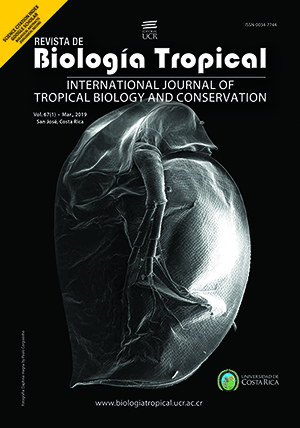Abstract
Dietary composition in amphibians may be influenced by several factors that cause their intraspecific variation, such as geographic distribution, ontogeny, seasonality, and sex of organisms. The objective of this study was to analyze the composition of the diet in adults of the Polymorphic Robber Frog Craugastor rhodopis in the mountainous region of central Veracruz, Mexico. A total of 77 adult individuals were collected during the rainy season of 2012, of which 66 had stomach contents. We performed an analysis of the intersexual variation in diet diversity, volume, number of prey, and number of prey categories consumed. The diet of C. rhodopis was composed by 20 categories. Orthoptera predominated in terms of number, volume, frequency of occurrence, and relative importance. Males consumed smaller prey items relative to females. Although both sexes consumed similar numbers of prey, we found a significant effect of interaction of sex and size of frogs on this variable, with small females consuming more prey than the large ones, whereas in males the opposite occurred. High consumption of orthopterans (at least in volume) is a common phenomenon within Craugastoridae and is possibly related to the success of some species in the ecosystems where they live. Although the composition of the diet was similar between sexes in C. rhodopis, we suggest that intersexual competition for trophic resources is minimal, given differences in prey size consumed by males and females.
##plugins.facebook.comentarios##

This work is licensed under a Creative Commons Attribution 4.0 International License.
Copyright (c) 2019 Ricardo Luría-Manzano, Marco Tulio Oropeza-Sánchez, José Luis Aguilar-López, Juan Manuel Díaz-García, Eduardo Pineda


